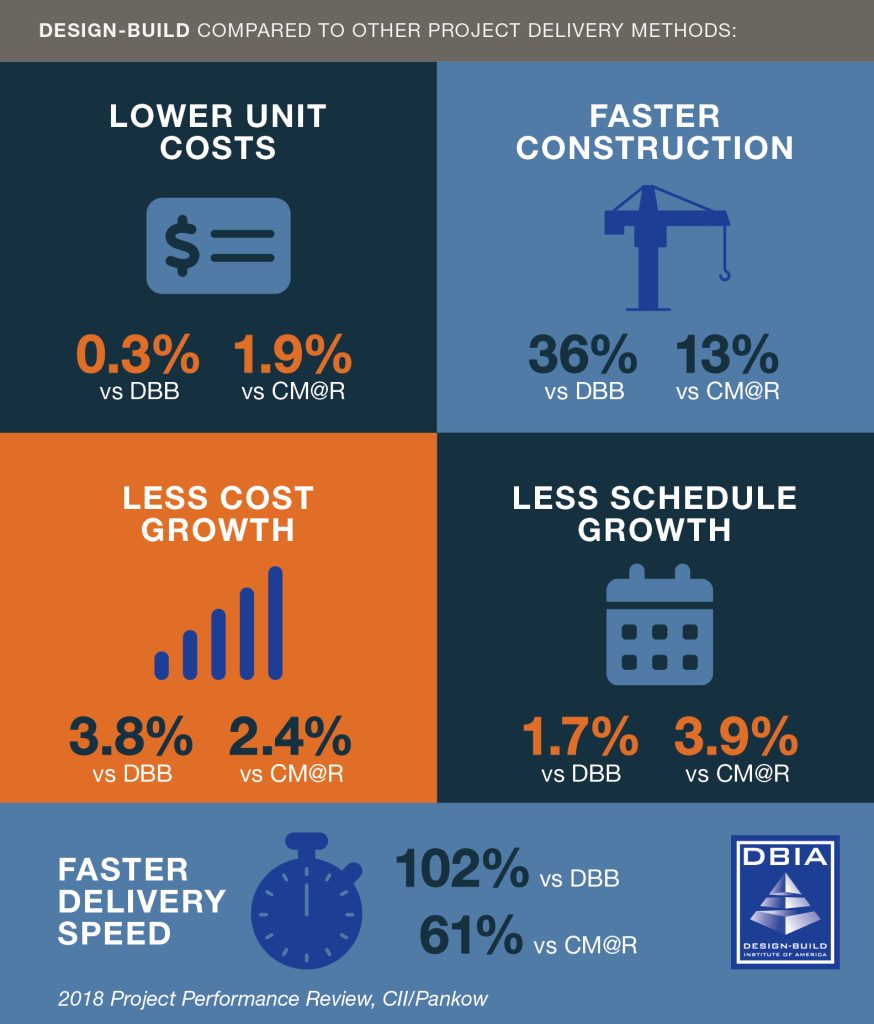Additional Resources
Once considered “an alternative form of project delivery,” design-build is now the fastest growing and most commonly used project delivery method in the United States. FMI Corporation projects design-build to represent over 47% of spending by 2028 and account for $2.6 trillion of construction spending over the 2024 – 2028 forecast period. It is widely used for both private and public sector (federal, state and municipal) projects and across all project types, including vertical (building) construction, transportation and water/wastewater markets.
In all other project delivery methods, there are separate contracts for design and construction. The single contract for both design and construction is the fundamental difference between design-build and other project delivery systems.
But design-build is more than a sole-source contract. It is as much a mindset as it is a process. It is intended to be a highly collaborative, fully integrated undertaking that is built on trust, mutual respect, teamwork, innovation and creative problem solving. Design-build works best when everybody makes the mental shift to think and act as a single entity focused on achieving shared project goals.
Design-Build Best Practices
DBIA’s Universal Design-Build Best Practices is a good place to start your design-build journey. This document categorizes 10 best practices and nearly 50 supporting implementing techniques into three areas 1) Procuring Design-Build Services, 2) Contracting for Design-Build Services and 3) Executing the Delivery of Design-Build Projects.
Learn More
Why Choose Design-Build?
Research over decades has consistently shown the innovation and collaboration inherent in design-build leads to faster project delivery, with more reliable performance and less cost and schedule growth.
Some of design-build’s benefits versus other project delivery methods:
- Higher quality project outcomes
- Collaboration that drives innovation
- Faster, more cost-effective project delivery
- Fewer changes, fewer claims and less litigation
- Allocation of risk to those who can best manage it
- Earlier knowledge of firm costs
With proven benefits like minimized Owner risk, cost savings and accelerated project completion, design-build stands at the forefront of successful and innovative project delivery.
Design-Build Flexibility
The growth of design-build can be attributed in part to the flexibility of Owners to choose a procurement approach or variation best suited to their needs and culture. The most popular variations of design-build are:
- Two-Step Best Value Design-Build
A two-step procurement process first identifies the most highly qualified design-builders then seeks design and cost proposals. The Owner selects the design-builder offering the best value proposal (a combination of design, project approach and contract price).
- Progressive Design-Build
The design-builder is selected primarily on the basis of qualifications. After selection, the Owner and design-builder collaborate to progressively advance the design and cost model toward a mutually agreeable design concept and contract price.
View DBIA’s Position Statement on the Flexibility of Design-Build or the Project Delivery Primer for a deeper dive into these variations.
Resources
DBIA offers a number of additional resources to download in our online Bookstore to help deepen your design-build knowledge:
Primers and Deeper Dives Position Statements Research and Reports Contract DocumentsDebunking Myths
Despite design-build’s impressive growth from what was once considered an alternative project delivery method to one that is now more mainstream, there are still many myths surrounding design-build, and it’s important to dispel them by providing the facts. Read some of the most common myths we often hear.
View Design-Build Myths & Facts Download Myths & Facts One-SheetProjects Database
The DBIA Projects Database is a unique place to browse hundreds of successful design-build projects. The Projects Database is searchable by project type, size and location and provides detailed information about cost/schedule, added value and innovative solutions that resulted from a collaborative design-build approach.
Search Project Database